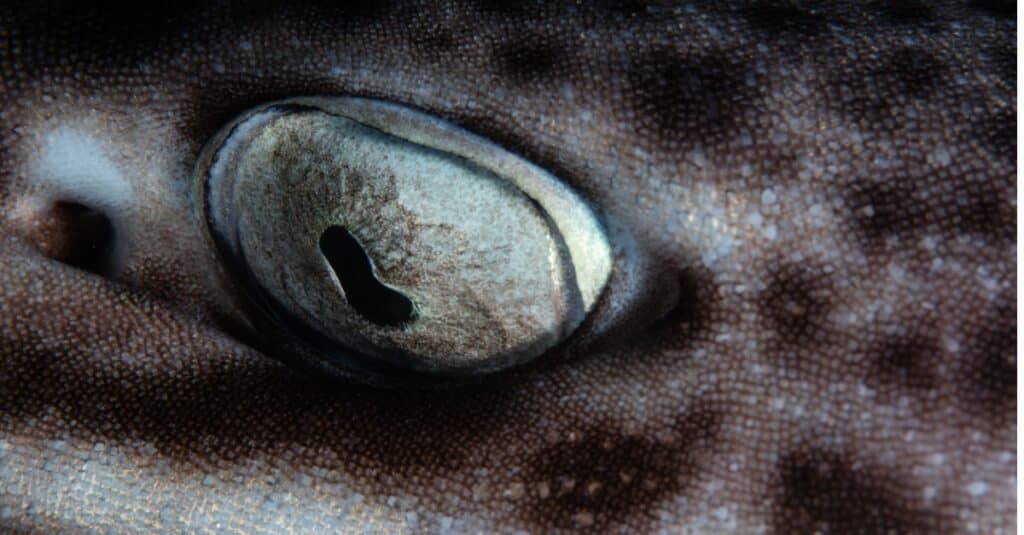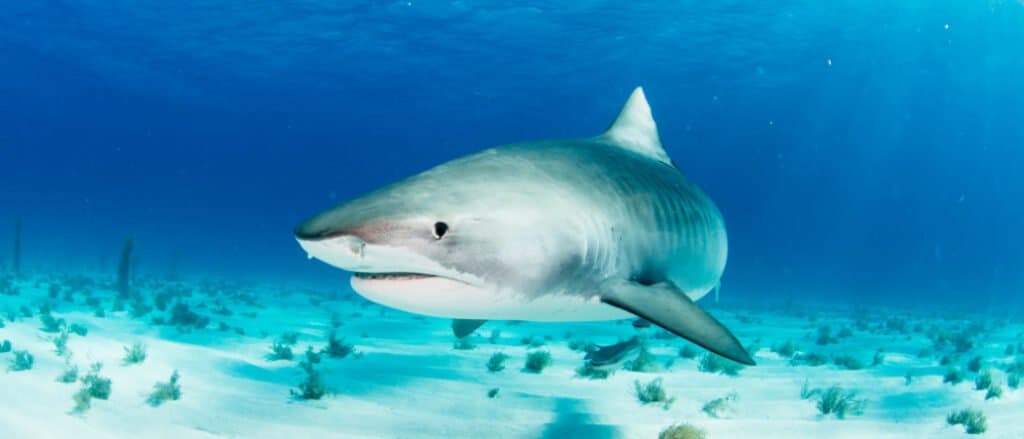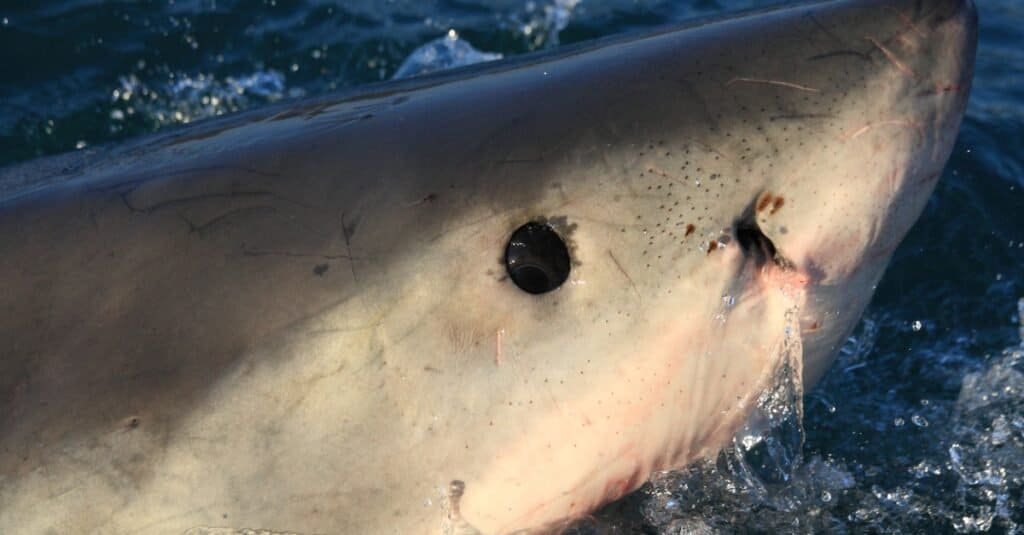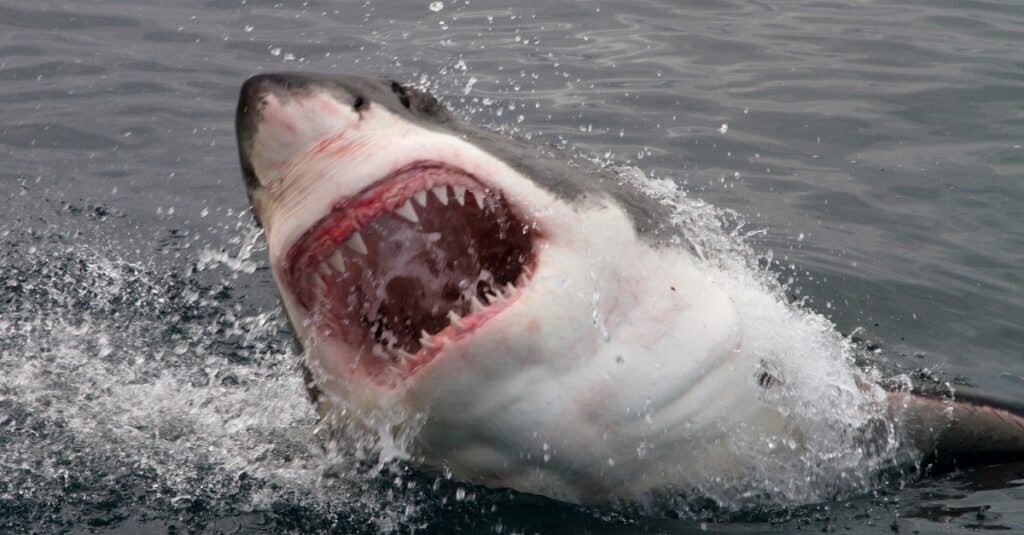There are more than 500 species of shark in the world today and they come in all different shapes and sizes. They are some of the most able predators in the world and are highly adapted for the areas that they live in. Sharks have some of the most advanced senses of any animal and are well known for their ability to smell blood, but what about sight? One of the most fascinating things is the deep, unfathomable depths of a sharks eye. Join us as we discover how sharks eyes work, and explore everything you need to know about them.
How do Sharks Eyes Work?

The eyes of a coral catshark
©iStock.com/Velvetfish
Sharks eyes have often been considered to be one of the most complex and least understood aspects of sharks. Therefore, it probably comes as a surprise that their eyes are actually pretty similar to ours. Just like us they have a lens, cornea, pupil, retina, and iris, and these parts all work virtually the same way ours do.
However, sharks have duplex retinas that contain both rods and cones. Rods and cones are the photoreceptor cells that determine light and dark (rods) and color (cones). For a long time it was thought that sharks lacked the necessary cells to see color. However, recent studies have shown that they are actually able to see in color, but it is not known to what extent. Incredibly, the amount of rods and cones differs between species, so some sharks can see better than others.
Sharks also have a unique feature that allows them to see well in dark or murky water. Tapetum lucidum is a layer of mirrored crystals that is located just behind the retina. Light goes through the retina, hits the crystals, and is then reflected back onto the retina. This means that the light is available to the retina twice and increases visibility in areas that have poor light. In fact, they can see approximately ten times better than we can in murky, dark, and clear water. This is a major advantage to sharks as there is very little light in the ocean the deeper it gets. Incredibly, cats also have this tapetum lucidum too. This is the reason why both cats and sharks eyes appear to glow in the dark.
Do Sharks have Good Eyesight?

Sharks can see ten times better than us in dim light
©Yoshinori/Shutterstock.com
Although it’s been thought that sharks don’t have the best eyesight (especially considering that they sometimes mistake us for seals), they actually do have pretty good eyesight in certain circumstances. We’ve already established that their eyesight is far superior to ours in dim light, but they can even change their field of vision whenever they want.
Sharks can see in both stereoscopic and monocular vision. Stereoscopic is three-dimensional vision which is how we see. Images from both eyes are combined which gives our vision shape, depth, and distance. Monocular vision uses the image from only one eye. Although monocular vision gives poor depth perception it increases the vision quality.
However, despite being able to see in good quality, sharks can only see to a distance of around 50 feet. They also have a couple of blind spots. Sharks eyes are located on each side of their head which allows for almost 360 degree vision.. Despite this they have a blind spot in front of their snout and behind the top of their head. So, as they can’t see that far they need to be pretty close to their prey before they attack, but equally, anything right in front of their nose they can’t actually see at all!
How do Sharks Protect their Eyes?

The eye of a great white shark
©iStock.com/Alessandro De Maddalena
Considering that sharks are some of the most able and active predators in the sea their eyes are obviously at great risk of injury when they attack their prey. Animals such as seals or even other sharks can easily do some serious damage while thrashing around or biting. So how do they manage to protect their eyes?
Sharks are commonly mistaken as not having eyelids because they don’t blink. They do actually have eyelids, they just don’t need to blink as the water constantly cleans their eyes for them. However, although sharks do have eyelids they don’t close fully. Therefore, sharks use one of two methods to protect their eyes and which method they use generally depends on the species. One method is to use a nictitating membrane. This membrane is transparent and slides down from underneath their eyelid to cover their eyeball, creating a protective layer. This membrane can be used when fighting with other sharks and when they are hunting.
The second method is used by sharks that don’t have the nictitating membrane and is the method that is used by great white sharks. There’s often been stories about how you can see the whites of their eyes when they attack. However, contrary to the belief that it’s just something that they do during a frenzied attack when fuelled by the smell of blood, they’re actually just protecting their eyes. As they don’t have a nictitating membrane, great whites roll their eyes back in their head to protect their eyes. This is called ocular rotation and means that in the last moments before they attack they are essentially blind. Therefore, the shark must rely on their other senses – such as electroreception – to locate their prey and attack.

Great whites roll their eyes back into their head when attacking
©iStock.com/Peter_Nile
Is Eyesight Essential to Sharks?
How essential eyesight is to sharks largely depends on the species and their habitat. Deep sea sharks that live in the darkest parts of the ocean where there is very little light rely more on their other senses, such as their lateral line and ampullae of Lorenzi (electroreceptors). However, sharks that live nearer the surface rely quite heavily on their eyesight. Some species – such as the Ganges river shark – swim along the bottom of the river while scanning the water above for prey. This means that they actively use their eyesight for hunting.
The photo featured at the top of this post is © iStock.com/Velvetfish
Thank you for reading! Have some feedback for us? Contact the AZ Animals editorial team.







